Introduction
In a unicellular organism, the single cell performs all the functions like respiration, digestion, etc. In multicellular organisms, different groups of cells work together in an organized manner to carry out the basic functions of the body.
The structural organization in animals is the same at the basic level, that is:
Cell→Tissue→Organ→Organ System
Organs of all animals at the higher level consist of one or more types of tissues, for example, the human heart consists of all four basic types of tissue that are epithelial, connective, muscular, and neural. The complexity of organs and organ systems follows a particular pattern. This pattern is known as the evolutionary trend.
Organ and Organ System
Cell forms the basic functional and structural unit of all animals. A group of cells, together with intercellular substances carrying a specific function, are called tissues. Tissues are organized together in a definite pattern to form an Organ – for example, Heart, Kidney, Stomach, etc. When two or more organs interact physically and chemically to perform a common function, they constitute Organ System. Examples are the Respiratory system, cardiovascular system, etc. Such an organization is necessary to ensure that millions of cells in an organism work together in an efficient and coordinated manner.
Animal Tissue
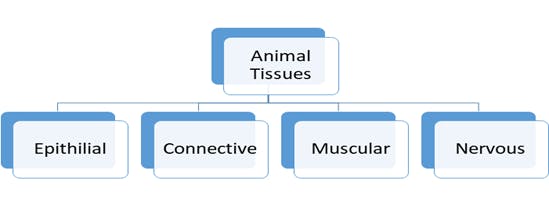
Epithelial tissue
These tissues have a surface facing a free space and are tightly packed with very little space between cells. There are two types:
- Simple epithelium: A single layer of cells that line body cavities, ducts, and tubes. They come in three types based on cell shape: squamous, cuboidal, and columnar.
- Compound epithelium: Consists of two or more layers and protects the skin.
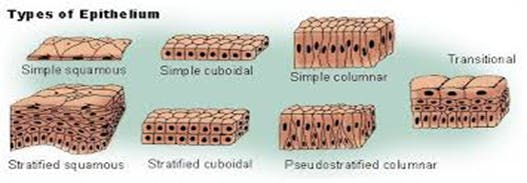
Connective Tissue
These tissues support and connect other tissues and organs in the body. They include soft connective tissue, cartilage, bone, adipose tissue, and blood. Connective tissues provide strength, elasticity, and flexibility to the body. They can be classified into loose connective tissue (like aerolar and adipose tissues), dense connective tissue, and specialized connective tissue.
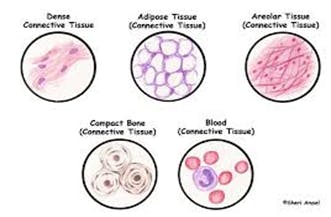
Muscular tissue
Muscles are made up of long, tube-shaped fibers arranged in parallel. They are composed of fine fibrils called myofibrils and are responsible for body movements. There are three types:
- Skeletal muscles: Bundled muscle fibers closely attached to skeletal bones.
- Smooth muscles: Involuntary muscles with narrow, spindle-shaped cells that line internal organs like blood vessels and the digestive system.
- Cardiac muscles: Involuntary muscle tissue found in the heart.
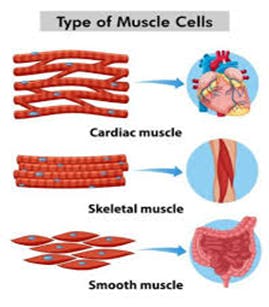
Neural tissue
Neurons, or nerve cells, are the building blocks of the nervous system. They are excitable cells that make up the neural system, providing support and protection.

Structural Organization of Cockroach
Morphology and Anatomy Of Cockroach
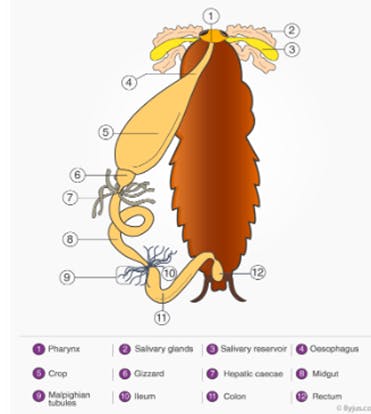
They are black or brown-bodied animals categorized under Phylum Arthropoda. They have a long antenna, legs and flat extension to the upper body wall concealing the head. The adults of the common species of cockroach are about 35-53 mm long, with wings extending beyond the tips of the abdomen in males.
- Their body is segmented into three distinct regions – head, thorax and abdomen. The complete body is covered by a hard chitinous exoskeleton.
- The exoskeleton in each segment has sclerites(hardened plates) which are joined to each other by a thin and flexible articular membrane (Arthrodial membrane)
- The triangular-shaped head lies anteriorly at right angles to the longitudinal axis formed by the fusion of six segments. The head has a pair of compound eyes.
- A pair of thread-like antennae(having sensory receptors) emerge from membranous sockets present in front of the eyes.
- Mouthparts consist of the labrum, a pair of mandibles, a pair of maxillae and a labium. A median flexible lobe serving as a tongue lies enclosed within the cavity by the mouthparts
- Thorax consists of the – prothorax, mesothorax and metathorax. Each of the thoracic segments has a pair of walking legs.
External Anatomy
- Body Segmentation: A cockroach’s body is divided into three main parts: head, thorax, and abdomen. These segments are covered by a hard exoskeleton made of chitin, providing protection and support.
- Head: The head houses the sensory organs, mouthparts, and compound eyes. Cockroaches have a pair of long, flexible antennae that serve as sensory organs for touch, smell, and taste.
- Thorax: The thorax contains three pairs of jointed legs, which are adapted for running and climbing. Each leg consists of segments with specialized structures for locomotion.
- Abdomen: The abdomen is the largest segment of the cockroach’s body. It contains vital organs such as the digestive, reproductive, and excretory systems.
Internal Anatomy
- Digestive System: Cockroaches have a complete digestive system with mouthparts adapted for chewing. Food is ingested through the mouth and passes through the esophagus into the crop and gizzard for storage and grinding, respectively. Digestion primarily occurs in the midgut, where nutrients are absorbed, and undigested material passes into the hindgut for excretion.
- Respiratory System: Cockroaches breathe through a system of air-filled tubes called tracheae. These tubes deliver oxygen directly to cells throughout the body, allowing for efficient gas exchange. Spiracles, small openings along the cockroach’s body, regulate the flow of air into the tracheal system.
- Circulatory System: Cockroaches have an open circulatory system consisting of a dorsal vessel and a series of sinuses. Hemolymph, the insect equivalent of blood, circulates freely within the body cavity, transporting nutrients, hormones, and waste products.
- Nervous System: Cockroaches have a well-developed nervous system consisting of a brain, ventral nerve cord, and ganglia. Sensory receptors located on the antennae, legs, and body surface detect environmental stimuli and transmit signals to the central nervous system for processing.
- Reproductive System: Cockroaches reproduce sexually, with males and females typically exhibiting distinct reproductive organs. Males have reproductive structures called testes, while females have ovaries. Fertilization occurs internally, and females produce egg cases called oothecae, which contain multiple eggs.
- Excretory System: Waste products are eliminated through a network of tubules known as Malpighian tubules. These tubules remove nitrogenous waste and excess ions from the hemolymph, which are then excreted as uric acid.
Behavioral Adaptations
- Nocturnal Habits: Cockroaches are primarily nocturnal, seeking shelter during the day and becoming active at night to forage for food.
- Omnivorous Diet: Cockroaches are opportunistic feeders, consuming a wide range of organic matter, including decaying plant material, fungi, and even dead insects.
- Agile Locomotion: Cockroaches are fast runners and adept climbers, enabling them to navigate various terrains and escape predators.
- Thigmotaxis: Cockroaches exhibit thigmotactic behavior, preferring confined spaces and surfaces in contact with their bodies, which provides a sense of security.
Structural Organisation of Frog

They have smooth and slippery skin due to the presence of mucus and absorb water through the skin. Their body is divisible into a head and trunk, where a neck and tail are absent. A pair of nostrils are found just above the mouth with bulged eyes covered by a nictitating membrane protecting them in water. The tympanum present on either side of the eye receives sound signals. The forelimbs(ending in four digits) and hindlimbs(ending in five digits) enable them to swim, walk, burrow and leap. They exhibit sexual dimorphism.
The body cavity of amphibians includes diverse organ systems with well-developed structures and functions. The organ system of a from includes:
- Nervous system
- Digestive system
- Excretory system
- Circulatory system
- Respiratory system
- Reproductive system
Integumentary System:
- Frogs have a smooth and moist skin covered in mucus, which helps them stay hydrated and facilitates gas exchange through cutaneous respiration.
- Their skin is permeable, allowing them to absorb water and oxygen directly from their surroundings.
- Specialized skin glands secrete toxins that provide defense against predators.
Skeletal System:
- The skeletal system provides support and protection to the frog’s body.
- It includes a vertebral column, skull, limbs, and rib cage.
- The absence of ribs in the abdominal region allows for the expansion of the body during breathing.
Muscular System:
- Frogs have well-developed muscles that enable various movements such as jumping, swimming, and catching prey.
- Muscles attached to the bones of the limbs facilitate locomotion, while muscles in the abdomen aid in breathing.
Digestive System:
- The digestive system of a frog consists of organs involved in ingestion, digestion, absorption, and elimination.
- Food is ingested through the mouth and passes through the esophagus into the stomach.
- The stomach secretes gastric juices to break down food, which then moves into the small intestine for further digestion and absorption of nutrients.
- Undigested material exits through the cloaca, a common chamber for waste elimination and reproductive functions.

Respiratory System:
- Frogs exhibit both cutaneous and pulmonary respiration.
- Cutaneous respiration occurs through the skin, allowing for gas exchange with the environment, particularly in water.
- Pulmonary respiration involves breathing through the lungs, which are located in the upper part of the trunk and connected to the buccal cavity.
Circulatory System:
- Frogs have a closed circulatory system with a three-chambered heart (two atria and one ventricle).
- Blood is pumped from the heart to the rest of the body through arteries and returns to the heart via veins.
- The circulatory system facilitates the transport of oxygen, nutrients, and waste products throughout the body.
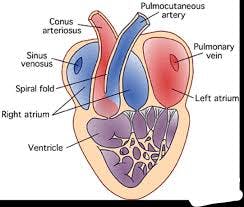
Excretory System:
- The excretory system removes metabolic waste products from the body, maintaining internal balance.
- Frogs have paired kidneys that filter waste from the blood and excrete it as urine.
- Urine is transported from the kidneys to the cloaca through ureters and expelled from the body along with feces.
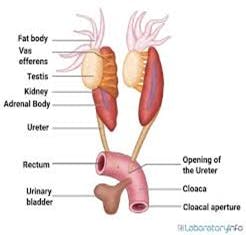
Nervous System:
- The nervous system coordinates sensory input, motor responses, and higher cognitive functions.
- It consists of the brain, spinal cord, and peripheral nerves.
- Sense organs such as eyes, ears, and tactile receptors provide information about the environment.
Reproductive System:
Frogs have intricately structured reproductive systems that ensure successful reproduction. Let’s delve into the details of their reproductive anatomy and life cycle:
Male Reproductive System:
- Male frogs possess a pair of yellowish ovoid testes, which are responsible for producing sperm.
- These testes attach to the upper part of the kidney via a structure called the mesorchium, which is a double fold of the peritoneum, the serous membrane lining the abdominal cavity.
- From the testes, 10-12 vasa efferentia originate and carry sperm. They enter the kidneys from the side and exit through Bidder’s canal.
- Bidder’s canal is a passage found inside the kidney that receives sperm from the vasa efferentia. It connects to the urinogenital duct and eventually enters the cloaca.
Female Reproductive System:
- The female reproductive system comprises two ovaries located near the kidneys.
- Unlike in mammals, the ovaries and kidneys in frogs have no direct functional relationship.
- Each ovary is connected to the cloaca via an oviduct, a tube responsible for transporting eggs from the ovary to the cloaca. The oviduct opens independently into the cloaca.
- A mature female frog can lay between 2500 and 3000 eggs at a time.
- Fertilization in frogs is external, meaning it occurs outside the female’s body and takes place in water.
Life Cycle:
- The life cycle of a frog exhibits complete metamorphosis, which includes distinct stages: egg, tadpole (larval stage), metamorphosis, and adult frog.
- Eggs are laid by the female frog in water, typically in clusters or gelatinous masses.
- After fertilization, the eggs hatch into tadpoles, aquatic larvae with gills and a tail for swimming.
- Tadpoles undergo metamorphosis, during which they gradually develop lungs, lose their gills, and grow legs.
- Eventually, the tadpole metamorphoses into an adult frog, equipped for life both on land and in water.
Ecological Importance
Frogs play a crucial role in ecosystems as they consume insects and pests, helping to control their populations and protect crops.
Previous Year Questions
Frog’s heart, when taken out of the body, continues to beat for some time. Select the best option from the following statements
I. Frog does not have any coronary circulation
II. Frog is a poikilothermic
III. Heart is autoexcitable
IV. Heart is “myogenic” in nature (NEET 2017)
A. (I) and (III)
B. Only (III)
C. (I) and (II)
D. (III) and (IV)
2. This feature is not found in Periplaneta americana (NEET- I 2016)
A. indeterminate and radial cleavage during embryonic development
B. Schizocoelom as the body cavity
C. metamerically segmented body
D. exoskeleton composed of N-acetylglucose-amine
3. Sperms in male cockroaches are stored in which part of the reproductive system?
(NEET – II 2016)
A. Vas Deferens
B. Testes
C. Mushroom glands
D. Seminal vesicles
4. Function of gap junction is to (2015)
A. facilitate communication between adjoining cells by connecting cytoplasm for rapid transfer of ions, small molecules and some large molecules
B. stop substance from leaking across a tissue
C. separate two cells from each other
D. performing cementing to keep neighboring cells together
5. Pick the correctly matched pair (2014)
A. Cartilage – loose connective tissue
B. Adipose tissue – dense connective tissue
C. Areolar tissue – loose connective tissue
D. Tendon – specialized connective tissue
6. Compared to those of humans, erythrocytes in frogs are (2012)
A. nucleated and without haemoglobin
B. nucleated and with haemoglobin
C. without nucleus but with haemoglobin
D. very much smaller and fewer










